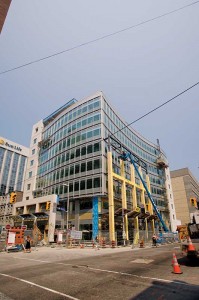Staying current with Canada’s energy code

For interior lighting, the basic principle of the prescriptive requirements is the actual installed power cannot exceed the allowance in the code as calculated using either the building area method or the space-by-space method. It is important to note only one of these methods can be used for the entire building. The space-by-space method can always be employed, but some criteria govern the use of the building area method.
To determine the interior lighting power allowance using the space-by-space method, the lighting power density for each space use (or its equivalent) is determined from a values table. This is then multiplied by the space’s gross interior floor area. The process is done for each space, and all are summed to yield the interior power lighting allowance for the entire project. The result is then compared against the installed interior lighting power.
As lighting of unoccupied interior spaces is an unnecessary use of energy, NECB calls for automatic lighting controls for many applications. Automatic controls are needed to shut interior lighting off in all spaces using either time-of-day operation, occupant sensors, or signals from a control or alarm system that the area
is unoccupied.
Areas exempted from the interior lighting control requirements include those where:
- lighting is necessary for 24-hour operation;
- patient care is rendered; and
- having automatic shut-off controls would negatively impact safety or security.
Each enclosed space must have at least one control device to independently turn off the general lighting within it. Certain spaces require the control be an occupant sensor, while others require a control device that can be activated either manually by an occupant or automatically by a sensor.
There are requirements for automatic daylighting controls for toplighting (i.e. skylights and rooftop monitors). When the daylighted area under skylights and rooftop monitors is greater than 400 m2 (about 4300 sf), a photocontrol must be installed to reduce general lighting.
Trade-off path
The trade-off method can only be used for interior lighting. The basic equation for the lighting trade-off path is the installed interior lighting energy (IILE) must be less than or equal to the interior lighting energy allowance (ILEA). The ILEA is calculated in accordance with the prescriptive space-by-space method.
The trade-off path uses a more detailed calculation procedure for allowable and installed lighting than the prescriptive path requires. It uses a series of equations and factors to calculate IILE and ILEA.
HVAC and NECB
Part 5 of the energy code deals with HVAC systems.
Prescriptive path
The minimum energy performance efficiencies of HVAC equipment (i.e. boilers, furnaces, air-conditioners, heat pumps, and water chillers) are stipulated in NECB. The system’s fuel source and capacity are considered in the performance required, and the equipment must not be under- or over-sized.
Air distribution systems must have a means to permit balancing. Ducts must be sealed and tested for air leakage. Duct and plenum insulation requirements depend on the difference between the temperature in the space where a duct is located and the temperature of the air carried in the duct. If a duct is used to carry both heated and cooled air, the largest temperature difference is employed to determine the insulation needed.
HVAC systems with mechanical cooling capacities larger than 20 kW, and air-handlers greater than 1500 L/s (about 3180 cfm), must be equipped with a means to cool with outdoor air. HVAC systems in dwelling units and hotel and motel rooms are exempted from this requirement. In general, outdoor air intakes and ducts or openings discharging air to the outdoors must have motorized dampers.
When an air economizer is used to meet the requirement for cooling with outdoor air, it must be capable of mixing 100 per cent outside air with the return air. If a water economizer is selected to achieve this goal, it must be capable of providing 100 per cent of the cooling load based on outdoor air temperature.
In cases when the flow from a central exhaust in multi-unit residential buildings is greater than 150 kW, heat recovery is required, but there is an exemption for climatic Zones 4, 5, and 6. Heat recovery applies only to the principal exhaust, not the exhausts for kitchen hoods or bathrooms. A heat-recovery apparatus used for a dwelling unit must be able to recover 50 per cent of the sensible heat. Although humidity is not included in the heat content calculation, an energy-recovery ventilator is permitted to be used to meet NECB’s heat-recovery demands.
The energy code mandates 40 per cent sensible heat recovery from the exhaust air of spaces containing pools with a surface area greater than 10 m2 (108 sf). An exemption is permitted where a dehumidification system provides 80 per cent of the dehumidification that would be accomplished by an exhaust system.
Under the code, ice arenas and curling rinks with a heating load elsewhere in the building must recover heat from the refrigeration system. The code provisions allow use of this recovered heat for space heating or service water heating.
Hydronic systems need to be able to be balanced. There are also piping insulation requirements based on the operating temperature of fluid, insulating material conductivity, and pipe diameter. In general, variable-flow pumping systems with a total pump system power (or nameplate power) greater than 7.5 kW must be able to reduce flow by 50 per cent or less.







